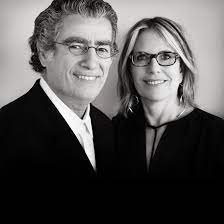13 Sep STUDY: Lorenzo Bruni interviews Giorgio Spanu
LB: First work you bought?
GS: One of the first pieces of Art Povera that we acquired was a 1983 Mappa by Alighiero Boetti, inscribed in Italian “Lasciare il certo per l’incerto e viceversa” and in Farsi “Io conosco tutti gli oceani che abbracciano la Terra” . 45 1/4 x 70 7/8 x 1 in. (115 x 180 x 2.5 cm). When we first started collecting, we purchased work by many of the artists of the Arte Povera movement including: Giovanni Anselmo, Alighiero Boetti, Pier Paolo Calzolari, Luciano Fabro, Piero Gilardi, Mario Merz, Marisa Merz, Jannis Kounellis, Giulio Paolini, Pino Pascali, Giuseppe Penone, Michelangelo Pistoletto, Emilio Prini and Gilberto Zorio.
LB: A few years ago you created a space where you can enjoy and see your works. Why did you feel this need?
GS: This year we celebrated the third anniversary of Magazzino Italian Art. The museum began as an idea. Our goal in creating The Olnick Spanu Collection has always been to share our knowledge and love of Italian artists and art movements that have been historically under appreciated in the United States, and Magazzino allowed us the opportunity to present these works. We never wanted to buy these masterpieces to just let them sit in a storage facility – we wanted to create a community. Now, the programs at Magazzino explore the impact and enduring resonance of postwar and contemporary Italian art on a global level. We also created a research center that includes a library and archive of over 5,000 books and publications of postwar and contemporary Italian art, design, and architecture. We present a range of public programs that include artist talks, film screenings, concerts, book presentations, scholarly lectures and workshops that celebrate Italian culture. We never imagined that Magazzino would be so successful, but we hope to continue its growth and creating more programs and special exhibitions of contemporary and emerging artists.
LB: What is your relationship with the fairs?
GS: We go to very few fairs. The only ones we regularly attend are: The Art Show-ADAA and The Armory Show in New York, Art Basel in Basel, Artissima in Torino, Frieze Art Fair in London, and Miart Art Fair in Milano.
LB: How has your relationship with galleries changed over the years?
GS: Our relationship with galleries has not changed over the years. We deal with very few selected galleries and these relationships persist throughout time. Our favorite gallery will always remain Galleria Christian Stein. The inaugural exhibition for Magazzino was a tribute to the gallery’s founder, Margherita Stein, who was one of the first champions of Arte Povera.
LB: How did you cope with the quarantine period? And how did it affect your relationship with art?
GS: With the leadership of director Vittorio Calabrese, at Magazzino Italian Art Museum we felt it was imperative to move our programs into the digital sphere. While our galleries were closed from March through July 2020, we found ways to bring people together online through Magazzino da Casa. The programs created were developed specifically to counter feelings of isolation. Each week for three months, we presented live- streamed Q&As with artists including Marinella Senatore, the unreleased films relating to recent museum projects, digital versions of exhibition catalogues, Instagram, Live lectures by leading scholars from around the world, music playlists contributed by community members on Spotify, and more. Community and collaboration is at the heart of what we do at Magazzino, so this felt like a natural extension of our mission.
One of the highlight projects of Magazzino da Casa was Homemade. At the beginning of quarantine, we saw how, across the art world, exhibitions were cancelled and artists were left vulnerable. We wanted to create a support network for Italian artists working in New York during this precarious period. We invited eight contemporary artists – Alessandro Teoldi, Andrea Mastrovito, Beatrice Scaccia, Danilo Correale, Davide Balliano, Francesco Simeti, Luisa Rabbia, and Maria D. Rapicavoli – to create a single work from isolation and share their process with us and the Magazzino audience digitally. We had weekly Zoom aperitivi that allowed regular moments of artistic exchange, forging a new community during this moment of global dislocation.
What emerged from this period was a body of work that demonstrated the resilience of creativity and the power of art to connect us. In our plans for reopening the museum, we decided to exhibit the works created by each of the artists. On view through September 7, 2020, Homemade includes approximately 30 works that show how each of the participating artists pushed their practice, used new methods and materials, and explored new issues. We will be creating a catalog as well that we are excited to present soon.
LB: Many fairs have worked on their online edition. Which of these impressed you the most or which did you follow?
GS: During quarantine, we did not experience any digital art fairs. For us, seeing an artwork in person is very important. We need to see the art with our own eyes in order to appreciate it fully. We have never purchased a work from a digital image alone.
LB: In this lockdown period have you discovered a particular artist to add to your collection?
GS: As we mentioned earlier, through the project of Homemade, we got to know the creative practices of the eight participating Italian artists – Alessandro Teoldi, Andrea Mastrovito, Beatrice Scaccia, Danilo Correale, Davide Balliano, Francesco Simeti, Luisa Rabbia, and Maria D. Rapicavoli – on a very personal level. This was a real privilege, and even more so to be able to present their work at Magazzino upon reopening. However, we did not acquire the works made for Homemade – the artists are free to do whatever they want with their pieces following the exhibition. In terms of adding to the Olnick Spanu Collection, we recently acquired wonderful works by Mario Merz, Marisa Merz, Luciano Fabro, Mario Schifano, Costantino Nivola, Carla Accardi, Maria Lai and Marisa Merz.
Authors
Lorenzo Bruni with Giorgio Spanu

Recent Posts
- STUDY: Lorenzo Bruni interviews Giorgio Spanu
- Quando l’arte chiama il collezionismo attraverso la sperimentazione. Ambizioni ed economie degli spazi no profit by Marianna Agliottone
- THE MIGRATION OF MEANING. Slow curating as a way to connect to place and people by Jacqueline Grandjean
- Initiatives in Istanbul by Pelin Uran
- Interview with Marja Bloem
BIO - Giorgio Spanu - Collezione Olnick Spanu & Magazzino Italian Art
Dove: New York
Da quando: verso la fine degli anni 80
Chi: Nancy Olnick e Girgio Spanu sono i fondatori di Magazzino Italian Art, fondazione non profit situata a Cold Spring, NY a circa 60 miglia a nord di New York. Magazzino Italian Art, con la direzione di Vittorio Calabrese e un team di venticinque persone, si dedica alla ricerca e a educare il pubblico americano all’arte italiana del dopoguerra e contemporanea. La collezione spazia dalla metà degli anni Cinquanta ad oggi. Il museo di 2.000 metri quadri, progettato dall’architetto spagnolo Miguel Quismondo, ha aperto nel giugno 2017.

